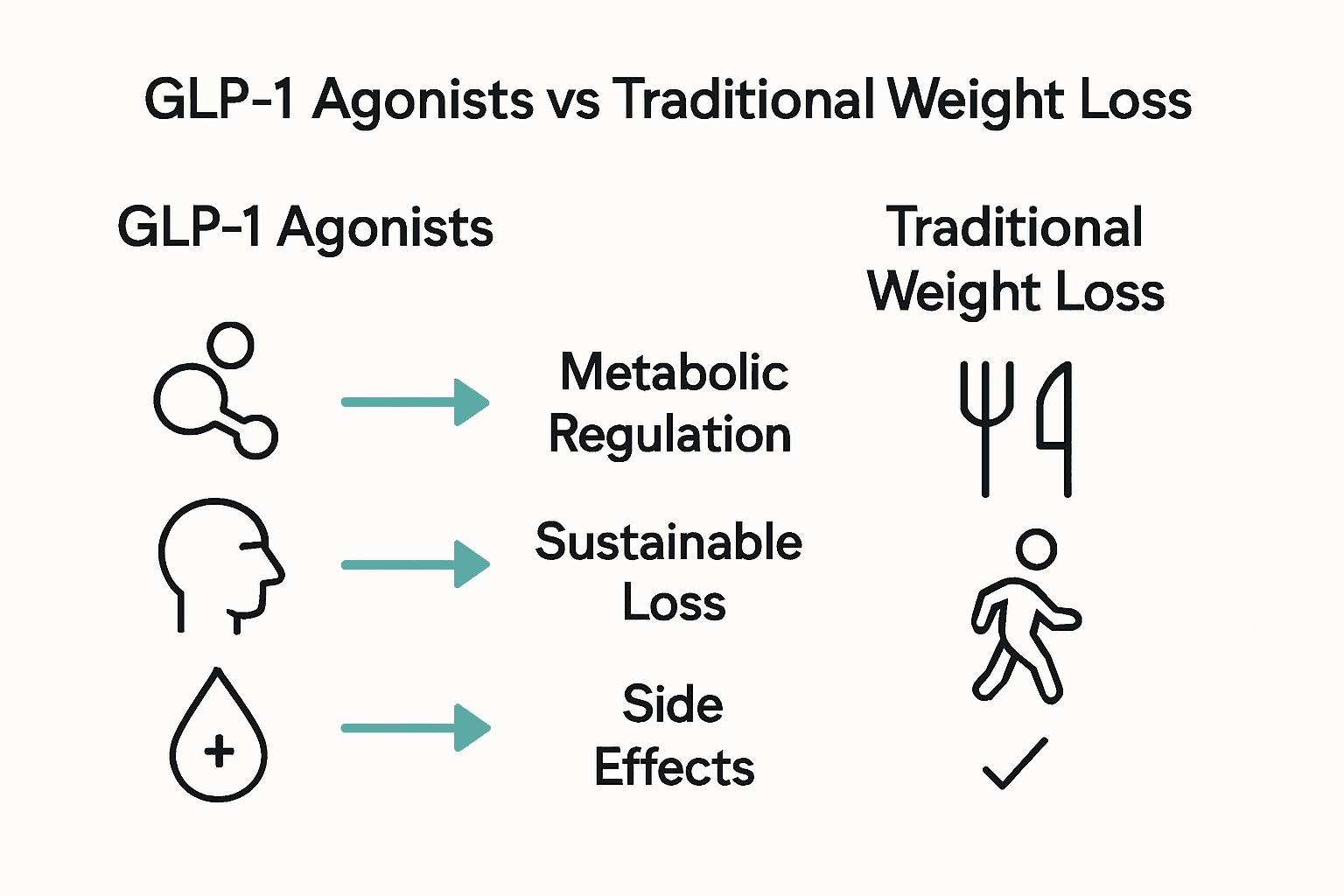GLP-1 Agonists Explained: Complete Weight Loss Guide
- Guppy Meds
- Nov 10
- 7 min read

Over 60 million adults in the United States are affected by obesity, prompting new solutions that go far beyond diet and exercise. GLP-1 agonists are making headlines for their ability to manage both weight and blood sugar at the same time, changing the way doctors address metabolic health. If you want to understand how these medications work and what sets them apart from other treatments, this guide brings clarity and up-to-date details you can trust.
Table of Contents
Key Takeaways
Point | Details |
GLP-1 Agonists Mechanism | These medications enhance metabolic health by mimicking the glucagon-like peptide-1 hormone, increasing insulin production and suppressing appetite. |
Diverse Applications | GLP-1 agonists are effective for managing type 2 diabetes and obesity, offering a multifaceted approach to weight loss and metabolic regulation. |
Telemedicine Integration | The rise of telehealth services makes accessing GLP-1 agonist prescriptions more convenient, allowing personalized treatment from home. |
Safety Considerations | While beneficial for weight management, potential side effects like gastrointestinal issues and rare risks require careful medical oversight. |
What Are GLP-1 Agonists? Core Principles Explained
GLP-1 agonists represent a sophisticated class of medications designed to mimic and enhance the body’s natural hormone responses, revolutionizing how we approach weight management and metabolic health. According to Cleveland Clinic, these medications work by emulating the glucagon-like peptide-1 hormone, triggering a complex series of metabolic interactions that help control blood sugar and support weight loss.
At their core, GLP-1 agonists function through a precise biological mechanism. As Drugs.com explains, these medications activate specific GLP-1 receptors in the body, initiating several critical metabolic processes:
Increased insulin production: Stimulating the pancreas to generate more insulin
Reduced glucagon secretion: Decreasing the hormone that raises blood sugar
Slowed gastric emptying: Making you feel fuller for longer periods
Appetite suppression: Naturally reducing food intake
Understanding GLP-1 agonists means recognizing their multifaceted approach to metabolic health. They don’t just target one aspect of weight management but create a comprehensive physiological environment that supports sustainable weight loss. For a deeper understanding of how these medications fit into modern treatment strategies, check out our GLP-1 Prescription Process: Step-by-Step Telehealth Guide.
These medications represent more than just a weight loss solution - they’re a sophisticated biological intervention that works harmoniously with your body’s natural systems. By mimicking existing hormonal processes, GLP-1 agonists offer a scientifically grounded approach to addressing metabolic challenges, making them a powerful tool in modern healthcare.
Different Types and Medical Uses of GLP-1 Agonists
GLP-1 agonists represent a diverse class of medications with significant potential for treating metabolic conditions. According to Drugs.com, these medications include several key pharmaceutical compounds such as semaglutide, liraglutide, dulaglutide, lixisenatide, and exenatide. These medications are primarily prescribed for managing type 2 diabetes, with some formulations demonstrating remarkable effectiveness in weight loss treatments.
The medical applications of GLP-1 agonists are both nuanced and expanding. Mayo Clinic highlights that specific formulations like liraglutide and semaglutide have been approved not just for diabetes management, but also for targeted obesity treatment. These medications offer a multifaceted approach to metabolic health:
Diabetes Management: Improving insulin sensitivity and glucose control
Weight Loss: Supporting significant and sustainable weight reduction
Metabolic Regulation: Helping balance complex hormonal interactions
Cardiovascular Support: Potentially reducing risks associated with metabolic disorders
While each GLP-1 agonist has unique characteristics, they share a common mechanism of enhancing the body’s natural metabolic processes. For individuals interested in understanding how these innovative treatments can be personalized, our Peer Reviewed Peptide Therapies: Complete Guide offers comprehensive insights into modern therapeutic approaches.
The evolving landscape of GLP-1 agonists represents a promising frontier in metabolic health treatment. By providing targeted interventions that work harmoniously with the body’s natural systems, these medications offer hope for individuals struggling with diabetes, obesity, and related metabolic challenges.

How GLP-1 Agonists Function for Weight Loss
Weight loss is a complex biological process, and GLP-1 agonists offer a sophisticated approach to metabolic management. According to Diabetes.org.uk, these medications promote weight loss through several intricate mechanisms that fundamentally alter how the body processes hunger and satiety signals.
The primary weight loss strategy of GLP-1 agonists involves a multi-pronged biological intervention. Le Monde explains that these medications mimic natural hormones responsible for controlling food intake, resulting in profound metabolic changes:
Appetite Reduction: Dramatically decreasing hunger signals
Improved Satiety: Making you feel fuller with less food
Slower Digestion: Extending the time food remains in your stomach
Metabolic Signaling: Recalibrating your body’s hunger response
These biological interventions create a powerful framework for sustainable weight management. For those interested in exploring personalized weight loss strategies, our How to Start Weight Loss Treatment Online Naturally guide provides additional insights into comprehensive treatment approaches.
By working harmoniously with the body’s natural systems, GLP-1 agonists represent more than just a medication - they’re a sophisticated tool for metabolic recalibration. The result is not just weight loss, but a holistic approach to understanding and managing your body’s complex nutritional responses.
Prescription Process and Telemedicine Access
Accessing GLP-1 agonist medications has been transformed by the rise of telemedicine platforms, making weight loss treatments more convenient and accessible than ever before. Associated Press highlights the growing trend of telehealth services enabling direct prescription of weight loss medications like Ozempic and Wegovy through digital platforms, revolutionizing how patients receive medical support.
The prescription process for GLP-1 agonists involves careful medical evaluation and personalized treatment planning. According to Diabetes.org.uk, these medications are typically prescribed to adults with specific health criteria, particularly those with type 2 diabetes or significant weight management challenges:
Comprehensive Health Assessment: Detailed medical history review
BMI Evaluation: Determining treatment eligibility
Metabolic Health Screening: Checking underlying health conditions
Personalized Treatment Plan: Tailoring medication to individual needs
For individuals looking to start their weight loss journey through telemedicine, our How to Start Weight Loss Treatment Online Naturally guide provides a comprehensive overview of the process, helping you understand what to expect during your virtual consultation.
The integration of telemedicine with advanced medical treatments represents a significant leap forward in healthcare accessibility. By removing traditional barriers like scheduling constraints and geographical limitations, these digital platforms empower individuals to take proactive steps toward their health and wellness goals with unprecedented convenience and professional support.
Risks, Side Effects, and Safety Considerations
Understanding the potential risks and side effects of GLP-1 agonists is crucial for anyone considering these weight loss medications. Drugs.com provides a comprehensive overview of the most common medical considerations associated with these treatments, highlighting that patients may experience a range of physiological responses.
The side effects of GLP-1 agonists can vary in both frequency and intensity. According to Mayo Clinic, patients should be aware of several potential health impacts:
Gastrointestinal Disturbances: Nausea, vomiting, and diarrhea
Metabolic Reactions: Potential changes in blood sugar levels
Rare but Serious Risks: Potential thyroid tumor development
Pancreatic Concerns: Possible inflammation or pancreatitis
For those interested in understanding more about potential treatment side effects, our Efectos Secundarios de Péptidos: Guía Esencial 2024 guide offers additional insights into managing medical treatments.
It’s important to approach GLP-1 agonist treatments with a balanced perspective. While these medications offer significant benefits for weight management and metabolic health, they are not without potential risks. Open communication with healthcare providers, regular medical monitoring, and a comprehensive understanding of your individual health profile are essential for safe and effective treatment.
Comparing GLP-1 Agonists to Other Weight Loss Options
The landscape of weight loss treatments has undergone significant transformation with the emergence of GLP-1 agonists, offering a more sophisticated approach compared to traditional weight management strategies. Mayo Clinic highlights a critical advantage: these medications not only address weight loss but simultaneously manage blood sugar levels, unlike many conventional diabetes medications that can potentially cause weight gain.
Traditional weight loss methods often fall short in providing comprehensive metabolic support. According to Le Monde, GLP-1 agonists represent a revolutionary approach to obesity treatment, offering substantial benefits over existing alternatives:
Hormonal Regulation: Directly influencing metabolic processes
Sustainable Weight Loss: More consistent results compared to diet plans
Metabolic Health: Addressing underlying physiological mechanisms
Reduced Side Effects: Less invasive than surgical interventions
For those seeking a comprehensive understanding of selecting the most effective weight loss treatment, our 7 consejos para elegir tratamiento de pérdida de peso guide provides additional insights into making informed healthcare decisions.
While GLP-1 agonists show remarkable promise, they are not a one-size-fits-all solution. The most effective weight loss strategy remains a holistic approach combining medication, nutrition, physical activity, and personalized medical guidance. These medications represent a powerful tool in the broader landscape of metabolic health management, offering hope for individuals struggling with traditional weight loss methods.

Take Control of Your Weight Loss Journey with Expert GLP-1 Support
Understanding the power of GLP-1 agonists to naturally support metabolic health is just the first step. If you are struggling with appetite control, sustainable weight loss, or managing complex metabolic challenges, Guppy Meds offers a simple, private, and accessible telemedicine solution. Our personalized treatment plans are designed to align with the key biological principles explained in the article, helping you reclaim your confidence and health without the hassle of in-person visits.

Discover a seamless way to access prescription GLP-1 medications through our dedicated Weight Loss GLP-1’s | Guppy Meds program. Start your journey today by scheduling a virtual consultation with licensed providers who tailor plans just for you. Visit Guppy Meds now and step into a healthier future with treatments grounded in science and delivered with care. Explore all options on our All Products | Guppy Meds page to learn how we can support your unique health goals.
Frequently Asked Questions
What are GLP-1 agonists and how do they work?
GLP-1 agonists are medications that mimic the glucagon-like peptide-1 hormone, enhancing natural metabolic responses. They stimulate insulin production, reduce glucagon secretion, slow gastric emptying, and suppress appetite, contributing to improved blood sugar control and weight loss.
What are the different types of GLP-1 agonists and their medical uses?
Common GLP-1 agonists include semaglutide, liraglutide, dulaglutide, lixisenatide, and exenatide. They are primarily used to manage type 2 diabetes and have also been approved for obesity treatment, promoting weight loss and supporting metabolic regulation.
How do GLP-1 agonists aid in weight loss?
GLP-1 agonists help with weight loss by reducing appetite, enhancing satiety, slowing digestion, and recalibrating hunger signals. This multi-faceted approach creates a physiological environment conducive to sustainable weight management.
What should I consider regarding the risks and side effects of GLP-1 agonists?
Potential side effects of GLP-1 agonists can include gastrointestinal disturbances, metabolic reactions, rare risks of thyroid tumors, and pancreatitis. It’s essential to discuss these potential risks with a healthcare provider and undergo regular monitoring during treatment.
Recommended
Comments